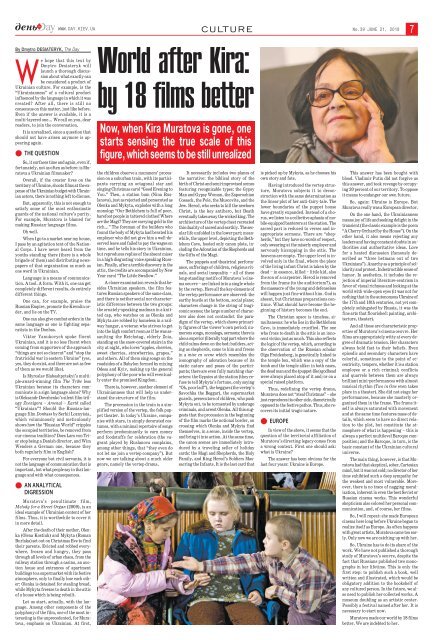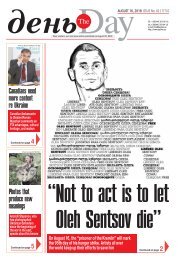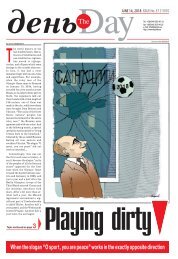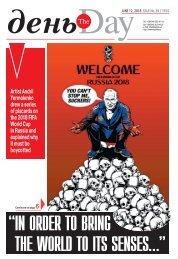You also want an ePaper? Increase the reach of your titles
YUMPU automatically turns print PDFs into web optimized ePapers that Google loves.
WWW.DAY.KIEV.UA<br />
CULT URE No.39 JUNE 21, 2018 7<br />
By Dmytro DESIATERYK, The Day<br />
We hope that this text by<br />
Dmytro Desiateryk will<br />
launch a thorough discussion<br />
about what exactly can<br />
be considered a product of<br />
Ukrainian culture. For example, is the<br />
“Ukrainianness” of a cultural product<br />
influenced by the language in which it was<br />
created? After all, there is still no<br />
consensus on this matter, just like before.<br />
Even if the answer is available, it is a<br />
multi-layered one... We call on you, dear<br />
readers, to join the conversation.<br />
It is unrealized, since a question that<br />
should not have arisen anymore is appearing<br />
again.<br />
● THE QUESTION<br />
So, it surfaces time and again, even if,<br />
fortunately, not as often as before: is Muratova<br />
a Ukrainian filmmaker?<br />
Overall, if the creator lives on the<br />
territory of Ukraine, shoots films at the expense<br />
of the Ukrainian budget with Ukrainian<br />
actors, there is nothing left to discuss.<br />
But, apparently, this is not enough to<br />
satisfy some of the most enthusiastic<br />
guards of the national culture’s purity.<br />
For example, Muratova is blamed for<br />
making Russian-language films.<br />
Oh well.<br />
When I go to a market near my house,<br />
I pass by an agitation tent of the National<br />
Corps. I have never heard from the<br />
youths standing there (there is a whole<br />
brigade of them) and distributing newspapers<br />
of that organization as much as<br />
one word in Ukrainian.<br />
Language is a means of communication.<br />
A tool. A form. With it, one can get<br />
completely different results, do entirely<br />
different things.<br />
One can, for example, praise the<br />
Russian Empire, promote the Kremlin order,<br />
and lie on the TV.<br />
One can also give combat orders in the<br />
same language as one is fighting separatists<br />
in the Donbas.<br />
Viktor Yanukovych spoke fluent<br />
Ukrainian, and it is no less fluent when<br />
coming from supporters of the approach<br />
“things are not so clearcut” and “stop the<br />
fratricidal war in eastern Ukraine” (yes,<br />
yes, they do exist, and there are not as few<br />
of them as we would like).<br />
Is Myroslav Slaboshpytskyi’s multiple-award-winning<br />
film The Tribe less<br />
Ukrainian because its characters communicate<br />
in a sign language alone? Why<br />
is Oleksandr Dovzhenko’s silent film trilogy<br />
Zvenigora – Arsenal – Earth called<br />
“Ukrainian”? Should the Russian-language<br />
film Donbass by Serhii Loznytsia,<br />
which voluminously and meticulously<br />
shows how the “Russian World” cripples<br />
the occupied territories, be removed from<br />
our cinema tradition? Does Lars von Trier<br />
stop being a Danish director, and Wim<br />
Wenders a German one, because they<br />
both regularly film in English?<br />
For everyone but civil servants, it is<br />
not the language of communication that is<br />
important, but what people say in that language<br />
and with what consequences.<br />
● AN ANALYTICAL<br />
DIGRESSION<br />
Muratova’s penultimate film,<br />
Melody for a Street Organ (2009), is an<br />
ideal example of Ukrainian content of her<br />
films. Thus, it is worthwhile to cover it<br />
in more detail.<br />
After the death of their mother, Olenka<br />
(Olena Kostiuk) and Mykyta (Roman<br />
Burlaka) set out on Christmas Eve to find<br />
their parents. Evicted and robbed everywhere,<br />
frozen and hungry, they pass<br />
through all levels of urban chaos, from the<br />
railway station through a casino, an auction<br />
house and entrances of apartment<br />
buildings to a supermarket with its festive<br />
atmosphere, only to finally lose each other:<br />
Olenka is detained for stealing bread,<br />
while Mykyta freezes to death in the attic<br />
of a house which is being rebuilt.<br />
Let us start, actually, with the language.<br />
Among other components of the<br />
polyphony of the film, one of the most interesting<br />
is the unprecedented, for Muratova,<br />
emphasis on Ukrainian. At first,<br />
World after Kira:<br />
by 18 films better<br />
Now, when Kira Muratova is gone, one<br />
starts sensing the true scale of this<br />
figure, which seems to be still unrealized<br />
the children observe a mummers’ procession<br />
on a suburban train, with its participants<br />
carrying an octagonal star and<br />
singing Christmas carol “Good Evening to<br />
You.” Then, a station bum (Nina Ruslanova),<br />
just as rejected and persecuted as<br />
Olenka and Mykyta, explodes with a long<br />
monolog: “Our Bethlehem is full of poor,<br />
barefoot people in tattered clothes! Where<br />
are the Magi? They are carrying gold to the<br />
rich...” The foreman of the builders who<br />
found the body of Mykyta had berated his<br />
employer who did not give him a well-deserved<br />
leave and failed to pay the wages on<br />
time, and he tells his story in Ukrainian,<br />
but reproduces replies of the absent miser<br />
in a high disgusting voice speaking Russian.<br />
Finally, after a terrible discovery in the<br />
attic, the credits are accompanied by New<br />
Year carol “The Little Swallow.”<br />
A closer examination reveals that besides<br />
Ukrainian speakers, the film features<br />
Russian speakers of the same class,<br />
and there is neither social nor characteristic<br />
difference between the two groups:<br />
the ornately-speaking madman in a knitted<br />
cap, who watches on as Olenka and<br />
Mykyta are robbed by homeless in a railway<br />
hangar, a veteran who strives to get<br />
into the high comfort room as if he was assaulting<br />
the Reichstag, elderly Zoia,<br />
standing on the snow-covered stairs in the<br />
city at night, who loves “apples, cherries,<br />
sweet cherries, strawberries, grapes,”<br />
and others. All of them sing songs on the<br />
roadsides of a Babylon formed by mixing<br />
Odesa and Kyiv, making up the general<br />
polyphony of the poor who will eventually<br />
enter the promised Kingdom.<br />
There is, however, another element of<br />
Ukrainianness that will help us understand<br />
the structure of the film.<br />
The procession in the train is a simplified<br />
version of the vertep, the folk puppet<br />
theater. In today’s Ukraine, companies<br />
with stars, in simply decorated costumes,<br />
with a minimal repertoire of songs<br />
perform predominantly to earn money<br />
and foodstuffs for celebration (the vagrant<br />
played by Ruslanova complains,<br />
among other things, that “they even do<br />
not let me join a vertep company”). But<br />
now we are talking about a much older<br />
genre, namely the vertep drama.<br />
It necessarily includes two planes of<br />
the narrative: the biblical story of the<br />
birth of Christ and semi-improvised scenes<br />
featuring recognizable types: the Gypsy<br />
Man and Gypsy Woman, the Zaporozhian<br />
Cossack, the Pole, the Muscovite, and the<br />
Jew. Herod, who seeks to kill the newborn<br />
Christ, is the key antihero, but Death<br />
eventually takes away the wicked king. The<br />
architecture of the vertep chest recreated<br />
this duality of sacred and earthly. The secular<br />
life unfolded in the lower part; meanwhile,<br />
the upper level, depicting the Bethlehem<br />
Cave, hosted only canon plots, including<br />
the Adoration of the Shepherds and<br />
the Gifts of the Magi.<br />
The puppets and theatrical performance,<br />
sufferings of children, religious rituals,<br />
and social inequality – all of these<br />
long-standing motifs of Muratova’s cinema<br />
oeuvre – are linked into a single whole<br />
by the vertep. Here all the key elements of<br />
the vertep performance are observed: the<br />
earthy bustle at the bottom, social plane;<br />
characters change in the string of tragicomic<br />
scenes; the large number of characters<br />
also does not contradict the paradigm<br />
of the vertep, which shows primarily<br />
figures of the viewer’s own period; numerous<br />
songs, monologs, sermons; there is<br />
also a superior (literally top) part where the<br />
child calms down on the bed; builders, acting<br />
as shepherds, come to him and freeze<br />
in a mise en scene which resembles the<br />
iconography of adoration because of its<br />
static nature and poses of the participants;<br />
there are even fully matching characters:<br />
the Gypsies at the station (they refuse<br />
to tell Mykyta’s fortune, only saying<br />
“Oh, poor lad!”), the beggars (the vertep’s<br />
Savochka the Beggar), the supermarket<br />
guards, persecutors of children, who push<br />
Mykyta out, to be tormented by underage<br />
criminals, and arrest Olenka. All this suggests<br />
that the procession in the beginning<br />
of the film marks the notional border, on<br />
crossing which Olenka and Mykyta find<br />
themselves, in a sense, inside the vertep,<br />
and bring it into action. At the same time,<br />
the canon scenes are immediately introduced<br />
by a traveling seller of holiday<br />
cards: the Magi and Shepherds, the Holy<br />
Family, and King Herod’s Soldiers Massacring<br />
the Infants. It is the last card that<br />
is picked up by Mykyta, as he chooses his<br />
own story and fate.<br />
Having introduced the vertep structure,<br />
Muratova subjects it to deconstruction<br />
with the same determination as<br />
the linear plot of her anti-fairy-tale. The<br />
lower boundaries of the puppet house<br />
have greatly expanded. Instead of a chorus,<br />
we listen to a collective aphasia of mobile-equipped<br />
banterers at the station. The<br />
sacred part is reduced to verses and inappropriate<br />
sermons. There are “shepherds,”<br />
but they have no words of respect,<br />
only swearing at the miserly employer and<br />
nervously hiccupping in the attic. The<br />
heavens are empty. The upper level is involved<br />
only in the final, where the place<br />
of the living infant Christ is taken by the<br />
dead – in essence, killed – little kid, also<br />
the son of a carpenter. Herod is removed<br />
from the frame (to the auditorium?), as<br />
the massacre of the young and defenseless<br />
will happen just fine without him. God is<br />
absent, but Christmas preparations continue.<br />
What should have become the beginning<br />
of history becomes the end.<br />
The Christian space is timeless, simultaneous:<br />
he who lies in the Bethlehem<br />
Cave, is immediately crucified. The one<br />
who froze to death in the attic is an innocent<br />
victim just as much. This also reflects<br />
the logic of the vertep, which, according to<br />
the observation of the Russian scholar<br />
Olga Freidenberg, is genetically linked to<br />
the temple box, which was a copy of the<br />
tomb and the temple alike: in both cases,<br />
the dead man and the (puppet-like) godhead<br />
were always placed atop of it and/or on a<br />
special raised platform.<br />
Thus, redefining the vertep drama,<br />
Muratova does not “steal Christmas” – she<br />
just reproduces its other side, diametrically<br />
opposed to the festive pathos. Thus, she recovers<br />
its initial tragic nature.<br />
● EUROPE<br />
In view of the above, it seems that the<br />
question of the territorial affiliation of<br />
Muratova’s directing legacy comes from<br />
a wrong context. First one should ask:<br />
what is Ukraine?<br />
The answer has been obvious for the<br />
last four years: Ukraine is Europe.<br />
This answer has been bought with<br />
blood. Vladimir Putin did not forgive us<br />
this answer, and took revenge by occupying<br />
20 percent of our territory. To oppose<br />
it means to endanger our own future.<br />
So, again: Ukraine is Europe. But<br />
Muratova really was a European director.<br />
On the one hand, the Ukrainianness<br />
means joy of life and seeking delight in the<br />
transient (the classic example is the poem<br />
“A Cherry Orchard by the House”). On the<br />
other hand, it also means rejecting any<br />
leaders and having constant doubts in authorities<br />
and authoritative ideas. Love<br />
for a heated discussion (famously described<br />
as “three hetmans out of two<br />
Ukrainians”). Anarchy as a principle of solidarity<br />
and protest. Indestructible sense of<br />
humor. In aesthetics, it includes the rejection<br />
of imperial literature-centrism in<br />
favor of visual richness and looking at the<br />
world with wide-open eyes (it was not for<br />
nothing that in the autonomous Ukraine of<br />
the 17th and 18th centuries, not yet completely<br />
subjugated by Russia, it was the<br />
fine arts that flourished: painting, architecture,<br />
theater).<br />
And all these are characteristic properties<br />
of Muratova’s cinema oeuvre. Her<br />
films are appropriately witty at every degree<br />
of dramatic tension. Her characters<br />
always hold fast to their beliefs. Even<br />
episodic and secondary characters have<br />
colorful, sometimes to the point of eccentricity,<br />
tempers, whether it is a station<br />
employee or a rich criminal; conflicts<br />
and quarrels between them are always<br />
brilliant mini-performances with almost<br />
musical rhythm (Two in One even takes<br />
place in a theater). She did not stage her<br />
performances, because she masterly organized<br />
them in the frame. The frame itself<br />
is always saturated with movement<br />
and at the same time features mass of details,<br />
which seem to have no direct relation<br />
to the plot, but constitute the atmosphere<br />
of what is happening – this is<br />
always a perfect multilevel Baroque composition;<br />
and the Baroque, in turn, is the<br />
basic constant of the Ukrainian cultural<br />
universe.<br />
The main thing, however, is that Muratova<br />
had that skeptical, sober, Cartesian<br />
mind, but it was not cold; no director of her<br />
time exhibited such a deep sympathy for<br />
the weakest and most vulnerable. Moreover,<br />
there is no trace of nagging moralization,<br />
inherent in even the best Soviet or<br />
Russian cinema works. This wonderful<br />
skepticism also colored her personal communication,<br />
and, of course, her films.<br />
So, I will repeat: she made European<br />
cinema here long before Ukraine began to<br />
realize itself as Europe. As often happens<br />
with great artists, Muratova came too early.<br />
Only now we are catching up with her.<br />
So, Ukraine has to do its share of the<br />
work. We have not published a thorough<br />
study of Muratova’s oeuvre, despite the<br />
fact that Russians published two monographs<br />
in her lifetime. This is only the<br />
first step: to publish such a book, well<br />
written and illustrated, which would be<br />
obligatory addition to the bookshelf of<br />
any cultured person. In the future, we also<br />
need to publish her collected works. A<br />
museum doubling as an artistic center.<br />
Possibly a festival named after her. It is<br />
necessary to start now.<br />
Muratova made our world by 18 films<br />
better. We are indebted to her.
















